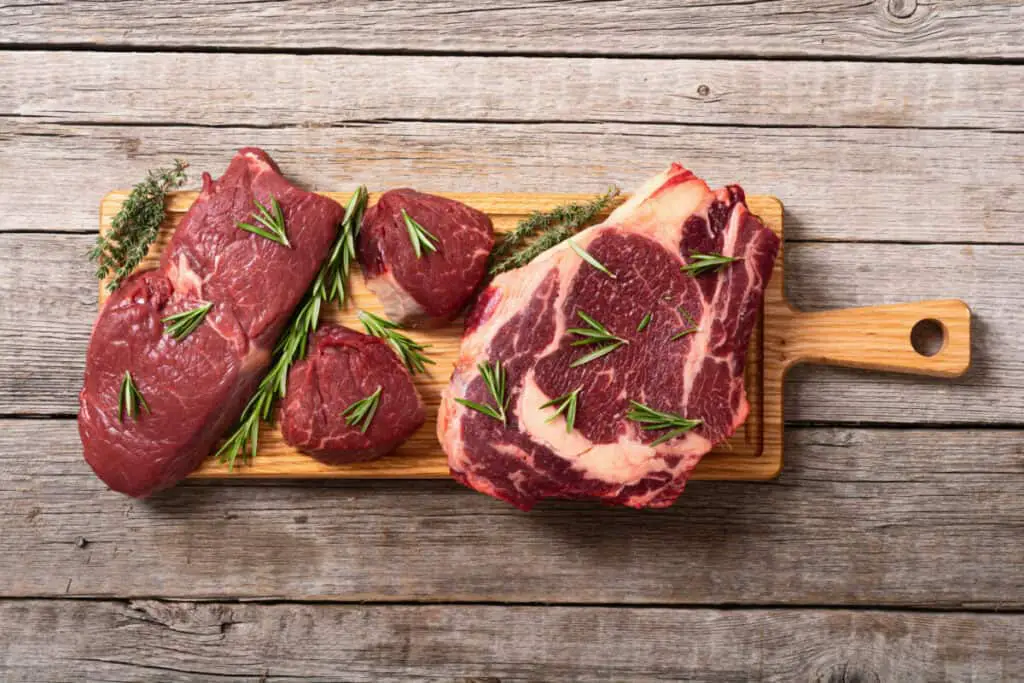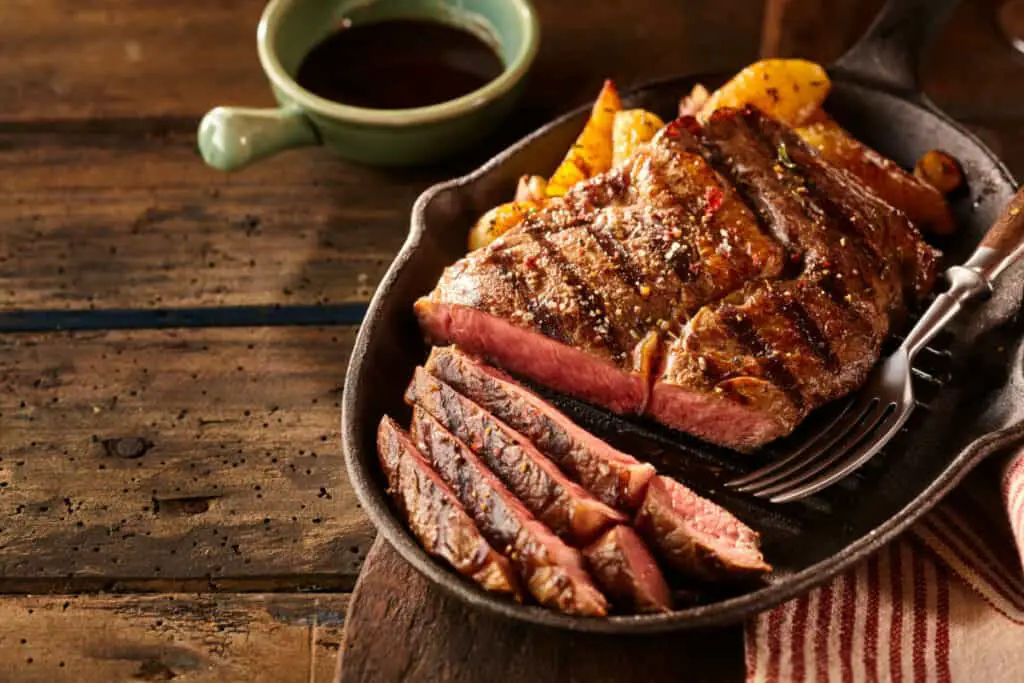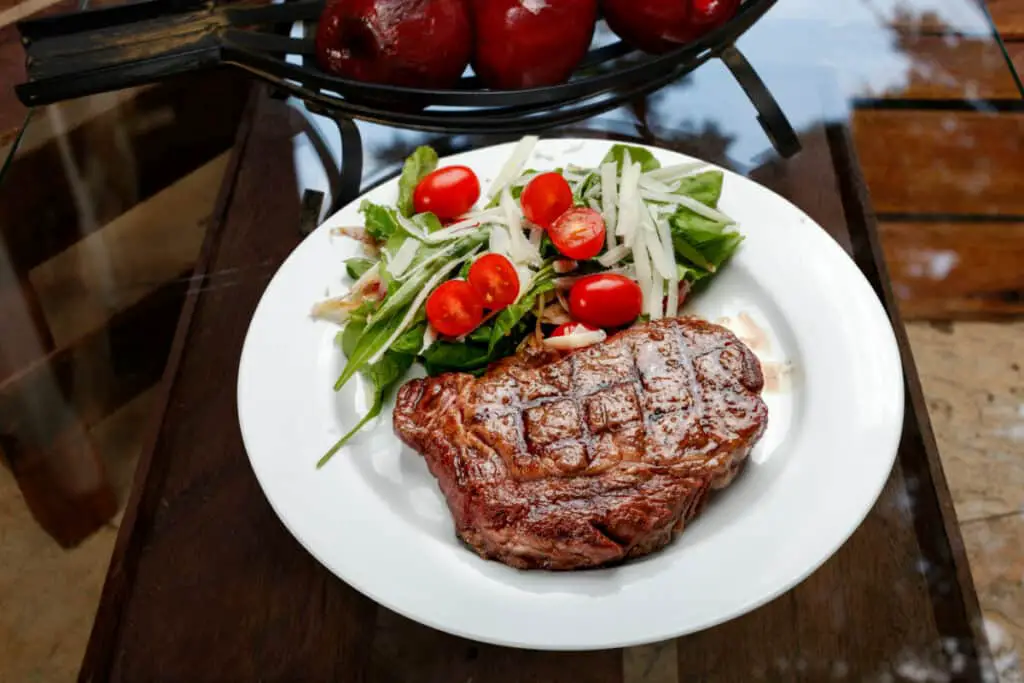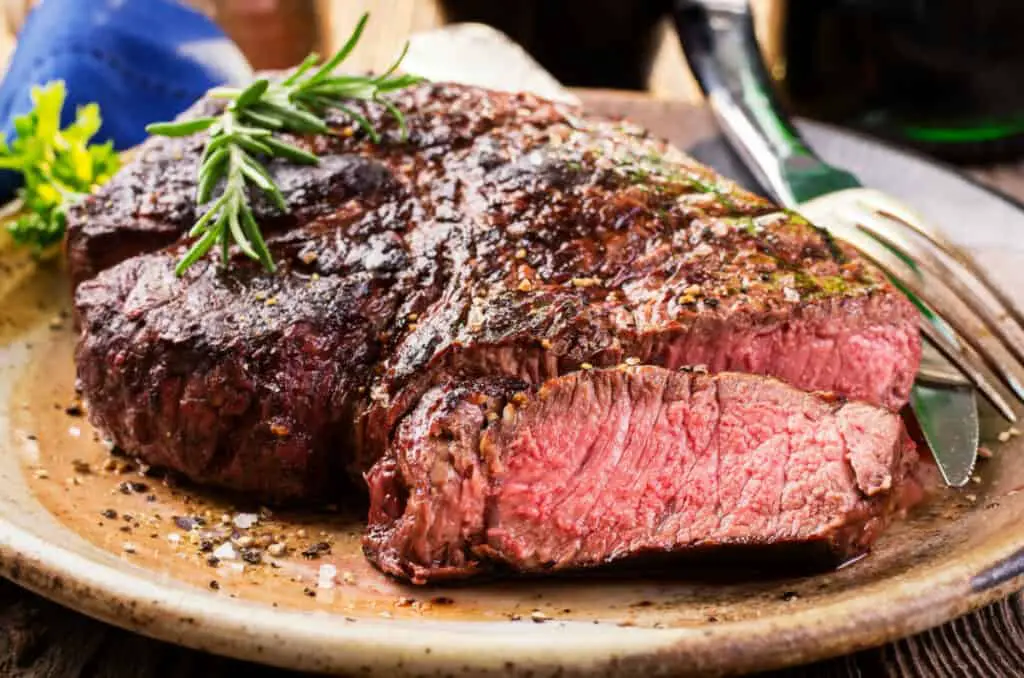This post contains affiliate links.
Ribeye steak can be delicious for a fancy meal on a Saturday night. It may even be great for a party of friends or guests. But it can be difficult to know exactly how much meat is the right amount.
The serving size for meat, or ribeye, is 3 ounces a day and it is recommended to not consume more than two servings of meat per day. Someone may eat more or less depending on their age, gender, activity level, health conditions, or diet. Since ribeye is red meat, be careful to not consume too much.

Continue reading to learn how much ribeye you should eat and plan for.
A Professional Opinion
When talking to nutritionist Danielle Nebeker about ribeye serving sizes, she said that “there are a lot of factors to consider. A typical serving size of meat is ~3 oz, which looks like a deck of cards. However, if the person has not had all their protein for the day, it is okay to have a larger portion.
The person’s age and activity level also factor into it. Red meat is high in saturated fat, so enjoying it occasionally is recommended in lieu of having it regularly. Focusing on plant-based protein such as beans, legumes, nuts, and seeds, as well as lean meat choices such as chicken, fish, and turkey, are healthier for our bodies, specifically our hearts.”
In the end, there a lot of different factors that influence how much ribeye one person should eat, besides the normal serving size. People should consider their personal health conditions, how many calories they need, and professional recommendations. If planning a party, you could ask if anybody has dietary restrictions for meat. If planning a meal for yourself, go see a doctor to get your personalized serving recommendation for ribeye.
Serving Size
It is not often that we think of serving sizes and how many we are consuming. Oftentimes in the western culture, our diets consist of multiple serving sizes at each meal, without even realizing it. When you go to Texas Roadhouse, what size steak do you order? The 8 ounce? Turns out that is more than double the normal serving size of meat per day, and you may have had other sources of meat before your dinner.
Whether you are planning a meal for yourself or multiple other people, it’s difficult to get the right amount of meat. You would think you just need to get the same number of servings as there are people, but we are used to eating more than a normal serving size. However, if you plan the other sides well, one serving of ribeye should be plenty.
The serving size for red meat is 3 ounces per day, after it is cooked. Meat weighs more before it is cooked and shrinks during the cooking process. When calculating how much the meat will weigh before and after cooking, multiply the ribeye’s weight before cooking by 75%. That is about how much it should weigh after cooking. You can then plan accordingly for how much ribeye meat you need for the meal.
If you don’t have access to a kitchen scale and can’t weigh the meat, there are other methods to predict the correct size. One serving of ribeye, or 3 ounces is usually the size of a deck of cards. To correctly proportion the meat based on age, give someone a piece of meat the size of their hands. It works for everybody because kids have smaller hands, hence they need smaller portions. It also depends on what sides you are providing with the meal. (Source )
)

Age and Gender
Serving size recommendations are usually for adults, and the amount differs for kids and teenagers. Kids will need less than the normal serving size, and teenagers will need more. Teenagers eat more because they are rapidly growing, especially if they are playing a sport. Athletes will always eat more than one serving of ribeye, as they are using more calories to play sports.
Children are growing as well, but they eat less than adults if they even eat any at all. Children can be very picky eaters so you don’t want to spend money on an expensive ribeye steak just for them to not eat it. Children and Teenagers also don’t need to worry about their health as much as adults, who now have a lower metabolism and need to think about future health problems they could have. (Source )
)
Activity Level
There’s a certain amount of calories we all need to survive, but that is if we just survive on the couch. As we go through our daily tasks like walking up the stairs or going grocery shopping, we are exerting energy and will need more calories, than if we had done nothing all day. There are those who like to be more active than most, those who go to the gym every single day, and those who intensely train whether is it heavy lifting for an hour or running 5 miles every morning.
Depending on how much activity you do throughout your day, you will need a different amount of calories. Those who lift a lot are going to eat more protein in order to build muscle and consume enough calories. In order to build muscle, you need to eat more calories, not less. So, if you are more active, you may need more than one serving of ribeye. If you have an average activity level, one three-ounce serving of ribeye should be enough.
Protein Needs and Health Benefits
The serving size for meat is 3 ounces a day, and the recommendation is to eat no more than two servings of red meat. However, there are exceptions. 10-35% of our calories should come from protein, so if we haven’t had enough protein for the day, it’s okay to have more than one serving of meat, but not every day. Meat does have some health benefits, but too much of a good thing is bad for you and your health. Eating too much red meat has been linked to cancer and other health-related diseases.
Red meat is a big debate among dieticians, but ribeye specifically has many health benefits. It is a great source of vitamins and minerals, has a large amount of protein, and has other health benefits. Ribeye has about 23.8 grams of protein for every three-ounce serving with only 10.8 grams of fat and no carbohydrates or sugar. Ribeye has zinc, selenium, niacin, vitamin b6, and vitamin b12. It’s important to get enough vitamins and minerals and ribeye steak helps us do that.
Ribeye also has a good amount of iron, which is something we as humans always end up lacking. Iron is very important for women to consume, as it helps babies develop correctly early on in pregnancy. One of the contributing factors to spina bifida is a lack of iron. However, this condition usually occurs before a woman even knows she is pregnant.

As for health benefits, ribeye and other red meats can help promote healthy weight loss. Red meat keeps you from gaining weight or regaining weight and when losing weight you don’t lose any lean body mass or muscle mass. Since red meat maintains muscle mass, it also reduces the chances of sarcopenia. Sarcopenia is when you lose muscle mass, muscle strength, and muscle functionality. This usually occurs in older adults.
Anemia is a condition characterized by loss of energy, dizziness, shortness of breath, headaches, fatigue, and other negative symptoms. Anemia can be prevented by intake of iron and vitaminb12, two things that ribeye has. Ribeye also has protein and zinc, two things that improve your immune system, overall keeping you healthy and safe from smaller sicknesses. Red meat may have a lot of saturated fat, but it still has some health benefits. (Source )
)
Saturated Fat
It is recommended that less than 10% of our daily calories come from saturated fat. Saturated fat is linked to several diseases and doesn’t benefit our health. Saturated fat increases your cholesterol levels causing issues with the heart and contributing to heart disease and strokes.
Since ribeye and red meat are high in saturated fat, you shouldn’t eat ribeye on a regular basis. It should be treated as something to eat on special occasions. There are several red meats to avoid, certain ways to cook them, and other non-red meat options to choose from. (Source )
)
Red Meat to Avoid
Ribeye is okay to eat on certain occasions, but there are some processed red meats we should try to avoid. You would be surprised at what these are. Processed red meats to avoid include bacon, sausage, ham, salami, and hot dogs. Unfortunately, these are very common meats that we Americans consume on a daily basis for breakfast, lunch, and dinner. It may be hard to avoid these, but your body will thank you in the long run. The reason we need to avoid these processed meats is because they have more unhealthy fats, sodium, nitrates, and other preservatives in them. Eating these processed meats will increase the chance of you getting stomach or colon cancer. It’s much healthier to consume leaner meats like Ribeye steak. (Source )
)

Best Way to Cook Red Meat
Even though ribeye meat has saturated fat in it, there are some measures we can take when cooking it, to make it the healthiest it can possibly be. Frying foods involves using extra fats or oils to cook them, adding unhealthy calories to our meals. It’s best to avoid frying and stick to the grill or oven.
However, be careful to not overcook your ribeye on the grill either. Burning your ribeye will produce something called heterocyclic amines, which causes cancer. Red meat already has the tendency to cause cancer when consumed in large amounts, so you don’t want to add any other cancer-causing elements. (Source )
)
Plant-Based Protein
Since we shouldn’t eat red meat often, we still need to get our daily protein in. There are so many other sources of protein that you don’t even realize are forms of protein! Of course, there is other meat such as chicken, fish, and turkey, but there is also plant-based protein such as beans, legumes, nuts, and seeds.
Some specific examples of plant-based proteins include sunflower seeds, chia seeds, peanut or almond butter, chickpeas, oats, whole grain products, and tofu. Choosing these types of proteins instead of regularly consuming ribeye and other red meats is much better for our health and heart and will reduce the chances of getting certain diseases.
It may be easier and more pleasant to consume red meat as it can be more tasty, but that is just becasue of all the fat it has in it. When cooking red meat like ribeye it is usually marinated in oils or cooked with another source of fat or butter, increasing the amount of saturated fat. In order to make eating ribeye more healthy when eating it, consider healthier options for flavoring the meat. We don’t always think about the long-term effects when eating food, just the temporary satisfaction and happiness it brings us.

By eating plant-based protein more than red meat, you will have a longer and happier life, it’s just hard to realize it now when the ribeye is sitting right in front of us. If you are planning on having ribeye for a dinner party, consider having additional options for protein such as leaner meats with fatty acids. (Source )
)
After learning about the dangers of saturated fat and the effects it has on our health, you may feel like swearing off ribeye forever. However, ribeye can have a lot of health benefits despite its amount of unhealthy fats. It is all about eating in moderation. The recommended serving size for ribeye is 3 ounces, but red meat should be limited and replaced with other sources of protein if possible.
It is different for everybody but is based on their age, gender, activity level, and pre-existing health conditions. Ribeye is a great source of protein for special occasions like celebratory meals and dinner parties. So happy party planning, meal planning, and eating!

